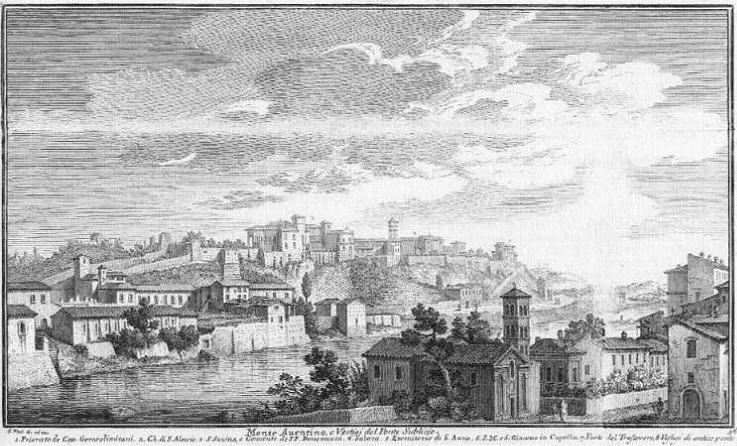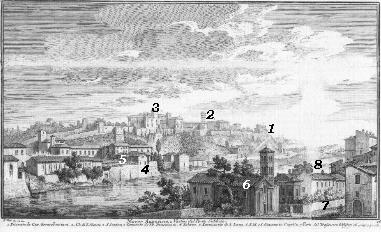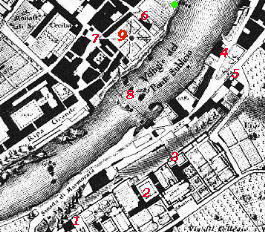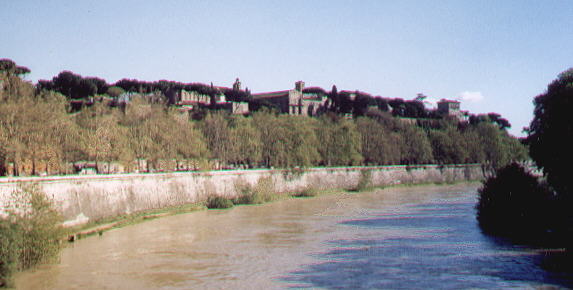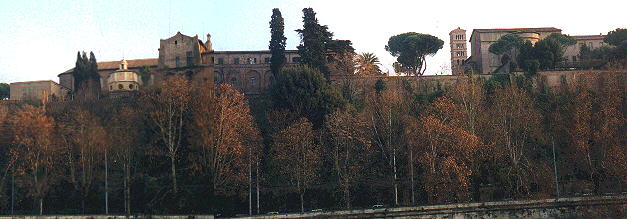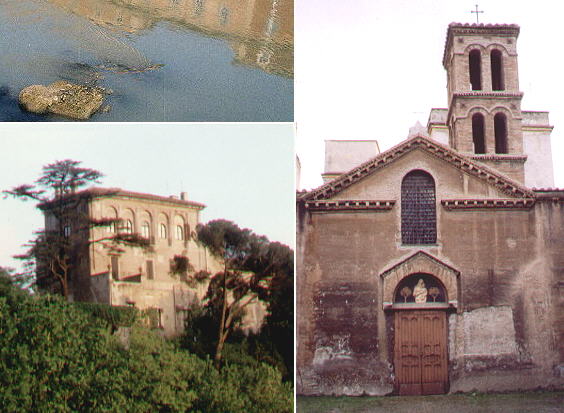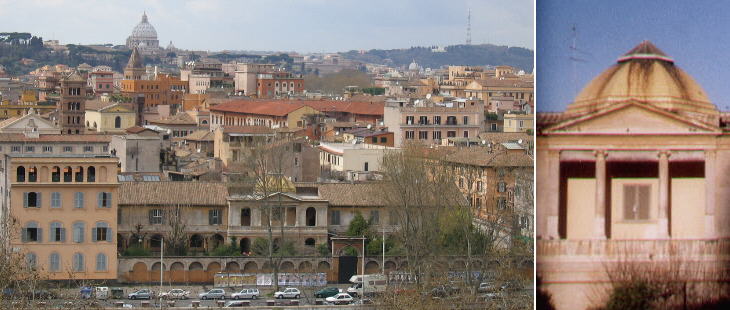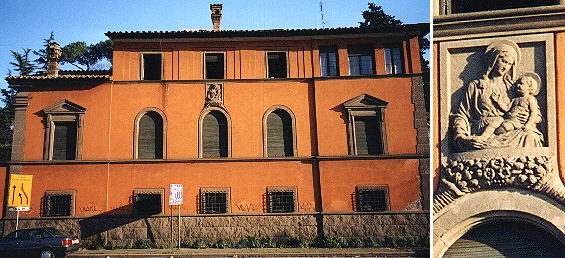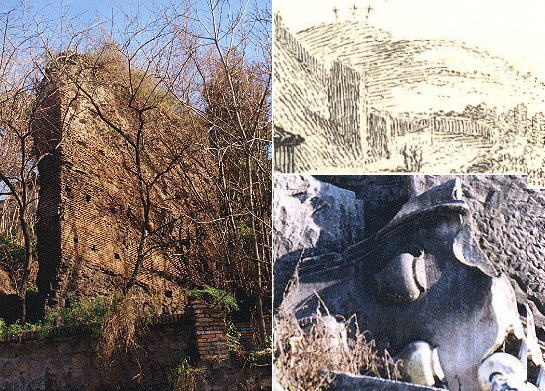

Monte Aventino
e Vestigi del Ponte Sublicio (Book
5) (Map
C3) (Day 5) and (Day 6) (View C11)
(Rione Ripa) and (Rione Trastevere)
In this page:
The plate by Giuseppe Vasi
Today's view
What's left (S. Maria in Cappella)
Casino di Donna Olimpia
Eremitorio (hermitage) di S. Anna
Ruins at the bottom of the Aventine
The Plate (No. 96)
This all embracing view of the Aventine seen from the Tiber clearly
shows the inner circle of walls which protected the monasteries from being
attacked. The Aventine was so remote from papal Rome, that security could
only be achieved by treating it as a separate little town. The title of
the plate refers also to the ruins of Ponte Sublicio, the first bridge made of timber to cross the river. The view is taken from the green dot in the small 1748 map here below.
In the description below the plate Vasi made reference to: 1) Palace of the Knights of Jerusalem (of Malta);
2) S. Alessio ; 3) S. Sabina; 4) Salara (salt-works); 5) Eremitorio di S. Anna;
6) S. Maria e S. Giacomo in Cupella; 7) Part of Trastevere; 8) Ruins of a Roman bridge.
1), 2) and 3) are shown in detail in other pages. The small map shows also 9) Casino di Donna Olimpia.
Today
The embankment of the river has destroyed the little mills and other
factories which characterized this area, but the view over the Aventine
is still striking.
What's Left
S. Sabina and S. Alessio are almost untouched
by time as well as the main building of the Knights of Malta. In front
of S. Michele
in summer when there is little water in the river, one of the pillars of
Ponte Sublicio can still be seen and in Trastevere the little church of
S. Maria and S. Giacomo in Cupella (today in Cappella), although in poor
shape, has managed to reach the year 2000.
Casino di Donna Olimpia
Donna Olimpia Maidalchini, the very powerful sister-in-law of Pope Innocentius X Pamphili (1644-55), built a small Casino overlooking the river.
In the XIXth century the Pamphili modified their property by adding a Neoclassic porch and destined it to provide a recovery for the old and the sick. The redesign of the river bed entailed the pulling down of the casino and a reduction of the gardens.
The large photo was taken from Rocca Savella on the opposite side of the river. The image shows behind the Pamphili buildings the bell tower of S. Cecilia and the church of S. Giovanni Battista dei Genovesi.
Eremitorio di S.Anna
The isolated chapel of S. Anna belonged to the hose-makers guild.
The modern building which replaced it retains some memory of the chapel in the
madonnella which portrays St. Anne with the Child.
Ruins on the Aventine
slope
The detail of the plate shows some ruins of the Roman walls built
to reinforce the foundations of the villas erected on the top of the Aventine.
The hill with the three crosses is Testaccio.
The ruins are still there. In addition to them there are some more recent
ruins, for example a coat of arms of Innocentius XII Pignatelli.
Excerpts from Giuseppe Vasi 1761 Itinerary related to this page:
Ponte Sublicio
In questa spiaggia fa ora bel vedere il grande ospizio di s. Michele, con la dogana,
ed il moderno sbarco de' navigli, che vengono dal mare, ed in mezzo al Tevere si
vedono le rovine dell'antichissimo ponte Sublicio, così detto da ilex albero forte,
e resistente all'acqua, o pure da' legni grossi, con i quali era costruito, che sublices
dicevansi. Era questo formato tutto di legno fin da' tempi più antichi, e da esso solevano
gettare ogni anno nel Tevere 30. uomini Greci; ma a persuasione di Ercole fu mutata
tale usanza, ed invece di uomini vi si buttarono dipoi figure di uomini fatte di paglia.
Questo fu quel ponte, che Orazio Coclite discese contro l'impeto de' Toscani,
mentre dall'altra parte veniva tagliato da' Romani, e poi gettatosi nel fiume col
suo cavallo passò a nuoto da' suoi. E perchè un tal valore venne attribuito ad
opera divina, e perchè in quella necessità fu tagliato con difficoltà, fu dipoi rifatto
senza chiodo alcuno, e fu dato in cura ad alcuni sacerdoti con ampia facoltà di ristaurarlo
e rifarlo quando bisognasse, onde questi furono detti Pontifices, ed il maggiore tra loro
Pontifex Maximus, la cui autorità fu di tanta possanza, ed onore, che poi se l'appropriarono
gli stessi Imperatori. Questo ogni anno si riattava con simile materia, e con grande
superstizione; e però fu ancora detto Ponte Sagro. Fin al tempo di Augusto, di Vespasiano,
e di Antonino fu conservato di legno: ma perchè spello rovinava, fu alla fine da Adriano
fatto di pietra, non già nel medesimo sito, ma poco discosto, perciò a distinzione di
quello, che egli fece presso il suo sepolcro, si disse ponte Emilio.
Rovine nel clivo dell'Aventino
Nessuno ha saputo dire di che sorta di edifizj fossero le grosse muraglie, che si vedono
appoggiate al monte Aventino; ognuno però vede, che sono avanzi di opere magnifiche degli
antichi. Poco più oltre camminando,evvi
La Salara nuova
E' questa una fabbrica, ove si purifica il sale, che si lavora sulla spiaggia del mare,
e sta appunto dove erano l'antiche saline. Quivi sulla strada fu ancora un arco eretto
per ordine del Senato al nome di Orazio per aver difeso, come dicemmo, il suddetto
ponte, e conservata la libertà alla patria. Poco più avanti si vede a piedi della
salita del monte Aventino la
Cappella di s. Anna
Questa piccola chiesa, quando il Papa abitava nel palazzo di s. Sabina era custodita
da' Palafrenieri: ma avendo poi edificata quella presso il palazzo Vaticano, restò
questa unita alla chiesa di s. Sabina, i cui frati vi tengono un Eremita per custodia.
Chiesa di s. Maria in Cappella
In sito molto basso sta questa piccola chiesa, la quale da principio era dedicata al ss. Salvatore;
ma poi essendovi da s. Francesca Romana aggiunto un piccolo spedale, prese l'uno e l'altra il titolo
di s. Maria in Cappella. Quindi nel 1540. avendola ottenuta la confraternita de' Barilari, si disse ancora
in cupella. Accanto di questa evvi l'amenissimo giardino del Principe Panfili con un casino
sulle sponde del Tevere.
|
Next plate in Book 5: Porto di Ripa Grande
Next step in Day 5 itinerary: S. Maria in Cosmedin
Next step in Day 6 itinerary: S. Cecilia
Next step in your tour of Rione Ripa: S. Sabina

Go
to  or to Book
5 or to my Home
Page on Baroque Rome or to my Home Page on Rome
in the footsteps of an XVIIIth century traveller.
or to Book
5 or to my Home
Page on Baroque Rome or to my Home Page on Rome
in the footsteps of an XVIIIth century traveller.
|


